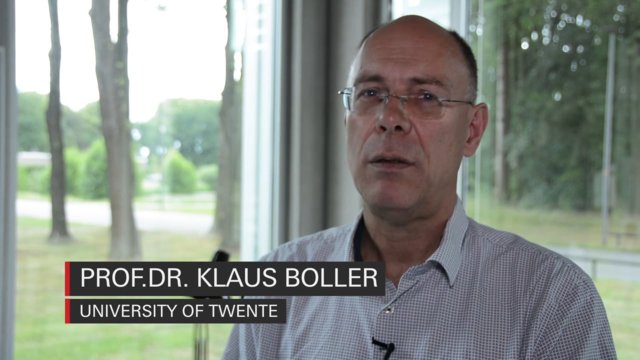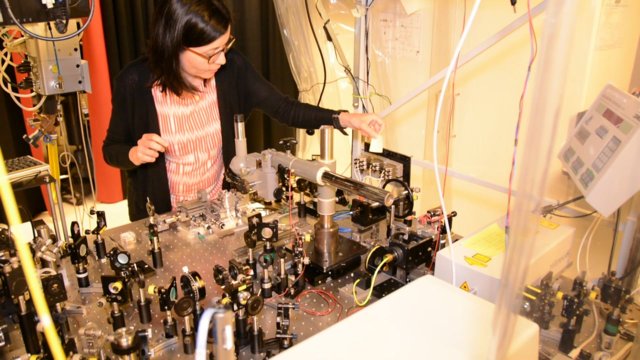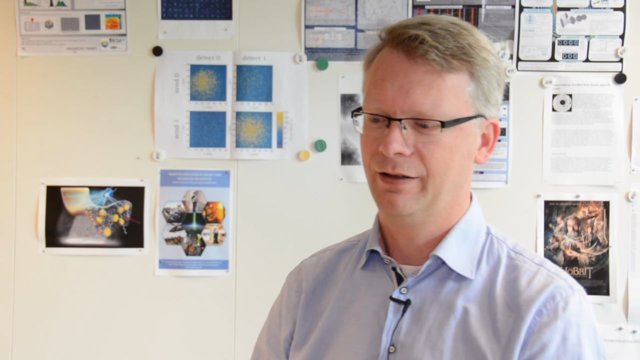Super-fast internet, self-driving cars, uncrackable security systems, new medical applications: the fast-growing field of photonics is at the heart of these and many other innovations. Today the University of Twente is hosting some of the most important scientists and industrial figures in the photonics world. During the World Technology Mapping Forum they will set the long-term agenda for this domain in order to accelerate innovation. Three photonics researchers at the UT's MESA+ Institute for Nanotechnology talk about the opportunities offered by photonics, and explain the strength of the university’s photonics ecosystem.
Electronics are at the foundation of most of the innovations of the past 50 years, but we are gradually reaching its technical limits. If we want better, faster, and more energy-efficient equipment then we will have to send and receive data using photons – light particles – instead of electrons. This is because photons can carry many times more information than electrons and with far lower losses. Klaus Boller defines photonics as “the acquisition, processing, and communication of information using light.”
Key enabling technology
Sonia Garcia Blanco agrees: “Photonics is a key enabling technology that makes numerous other innovations possible – things like faster and better data communication, low-energy data centres, and new methods of detecting disease.” However, the use of photons demands completely new chips and components. Many of these components are already under development, but now that the technology is starting to mature Garcia Blanco feels that global standards need to be set to help accelerate these developments. “The Forum is helping to close the gap between the promise and the reality.”
“When developing electronics, Moore’s Law tends to govern innovation,“ explains Pepijn Pinkse. In his opinion, the road map that was drawn up during the first World Technology Mapping Forum – and which will be discussed and updated this year at the University of Twente – fulfils a comparable role in his professional field. “There needs to be a shared destination, so that scientists, and especially industrial parties, know what they’re aiming for.”
Boller adds: “The roadmap is absolutely not a way of fragmenting the market; it reflects the latest scientific and technological developments, including bottlenecks and business opportunities. For scientists it is a yardstick of the social relevance of their research, and for companies and authorities it is an excellent guide for focusing investment.”
Collaboration
Because of the complexity of photonic components, pure research scientists and engineers need to work together. In Pinkse’s view this is precisely Twente’s strength. “The University of Twente employs the country’s largest concentration of optical research workers, and we have a unique level of collaboration with the industry. Some important companies in the field have arisen from the university. Our scientific research means that we have a better understanding of how photonic systems operate at the fundamental level, and this knowledge allows industrial parties to innovate in a more focused way.” According to Pinkse, the University of Twente also plays an essential role in training a new generation of photonics scientists and engineers. “Our students are in enormous demand.”
In photonic applications light has to be generated, processed and detected at an extremely small scale. One of the most important materials or ‘platforms’ for these operations is silicon nitride. According to Boller this platform first arose, twenty years ago, at the University of Twente, the result of curiosity-driven, open-ended research. “Over the years a lot of research work has been done on it, so its characteristics are now well known and it has become a very reliable platform. The power of this platform is that you can store light extremely well on a very small surface.”
Combinatory power
Despite the power of the silicon nitride platform, in Boller’s view no single platform is ideal. “Every platform has its advantages and disadvantages. You can’t make a car out of steel, plastic or aluminium alone, and for photonic applications – for which complexity is essential – you also have to combine different platforms onto a single chip.” This process is termed packaging, and in Boller’s view this combinatory power is the strength of the Twente photonics ecosystem.
“Packaging is the key to developing new photonic applications, because it’s an essential step in serial production,” Garcia Blanco adds. “And Twente excels in packaging.” As an example she mentions the newly-launched company Phix, which Develops advanced assembly and packaging processes to produce photonic modules on a large scale. “This sort of development is a crucial step forward for photonic applications.”
Boller, Garcia Blanco and Pinkse
Professor Klaus Boller leads the research group Laser Physics and Nonlinear Optics (LPNO), whose projects include working on new light sources for chip-based photonic applications. “In this field it’s critical to be able to control the information carrier, light, as tightly as possible. We want to make the light we create ‘supercoherent’.” Boller recently set a world record; working together with the company Lionix, he developed the world’s most narrowband diode laser on a chip.
Dr Sonia M. Garcia-Blanco is an Associate Professor in the Optical Sciences (OS) research group, specializing in the development of novel active photonic materials, integration processes and devices for applications in different fields, such as disease diagnostics and monitoring. She has worked on a new diagnostic aid to detect cancer biomarkers; on a portable device that detects Type 1 and Type 2 diabetes at an early stage; and on chip-mounted sensors that can monitor the quality of drinking water.
Professor Pepijn Pinkse is in the Complex Photonic Systems (COPS) research group, working on nanophotonics and quantum optics. His research activities include work on uncrackable quantum-based security solutions, on extremely thin fiber systems that allow imaging within blood vessels; and on fundamental research into methods for securely distributing cryptographic keys to enable secure communications. He recently succeeded in sending over 10 bits of information using a single photon.








